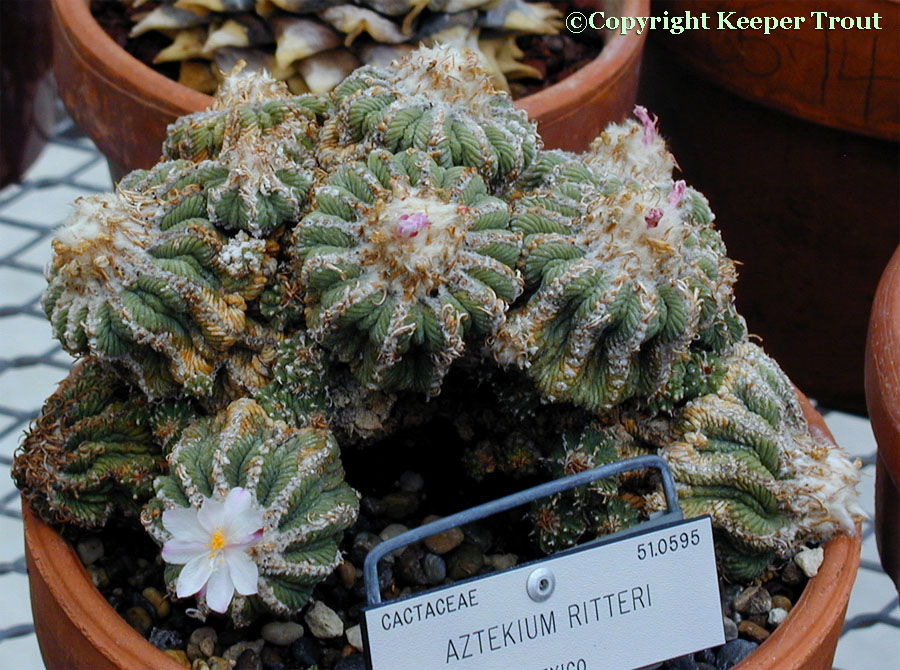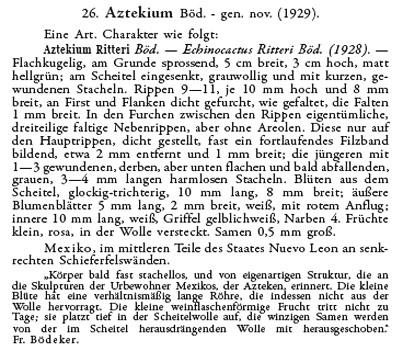Aztekium ritteri (Bödeker) Bödeker
Friedrich Boedeker (1929) Monatsschrift für Kakteenkunde, 1: 52. Aztekium ritteri
Friedrich Boedeker (1928) Zeitschrift für Sukkulentenkunde. Berlin 3 (14): 305–306. Echinocactus ritterii
Small amounts of mescaline have been reported.
Etymology: The wonderful texture of its surface has been likened to some Aztec motifs, hence the genus name Aztekium. Friedrich Ritter (who had been living in Mexico) was the specific namesake.
Habitat: From Nuevo Leon, Mexico growing in xeric scrub on limestone and gypsum cliffs.
Often remains solitary but may be freely offsetting from base with age (or if grafted or after exposure to pesticides & fungicides).
Greyish-green to grey body is broad and rounded to around 2 inches in
diameter; with a depressed wooly top.
Short napiform taproot.
9-11 ribs, [Ed.: Sometimes swirling] folded, with subsidiary and narrower ribs in between.]
Cultivated plants tend to be more green. Especially so on grafted plants. This is considered a detractant to the beauty of this plant by most authorities and serious collectors.
Areoles are closely set and bear white hairs.
Few spines; weak, bent or contorted. Usually 1-3; 3-4 mm in length.
White flowers 8 mm in diameter, appearing to have a stalk.
[Pizetti describes flowers as being about 1 cm wide; with white segments and outer perianth parts with pink edges. Anderson 1998 describes the flowers as white to light pink and appearing sporadically throughout the summer.]
Pink fruit is berrylike and appears only when ripe.
Black seeds are 0.5 mm long.
Backeberg 1977: 79-80 and
Pizetti 1985 entry #15.
Backeberg noted that there is also a form with flower that is longer (has longer stalk)
See also Backeberg 1961 [5: 2890-2892], (includes pictures on page 2891, fig. 2722, and the larger flowered form in flower, fig. 2723.) and Lamb & Lamb 1971 [2: 378] (with picture). Pizetti has color picture.
Habitat photos: Chastek 1994 Kaktusy 2: 40-41
Backeberg & Pizetti (& many others) describe the species as cold sensitive but I have seen them tolerate hard freezes (6°F) in a covered but unheated outdoor cactus bed Austin Texas when totally dry. I would recommend protection from freezing despite that lucky experience.
Once considered an endangered species due to being found only in a restricted area experiencing heavy collection activity. More populations across a broad range have since been discovered. The habitat includes inaccessible populations due to restricted access for both humans and browsers so it has been downgraded to become listed as a species of “Least Concern“.
B. Fitz Maurice & W.A. Fitz Maurice 2013. Aztekium ritteri. The IUCN Red List of Threatened Species. Version 2014.2. www.iucnredlist.org.
Reported analysis:
(Plants greenhouse grown in Czechoslovakia)
N-Methyltyramine (0.0031% by fresh wt.)
3-Methoxytyramine (Less than 0.0001% by fresh wt.)
Hordenine (Less than 0.0001% by fresh wt.)
N,N-Dimethyl-3,4-dimethoxyphenethylamine (0.0036% fresh wt.)
Mescaline (0.0009% by fresh wt.) (Which is not quite a mg per kg.)
Anhalidine (0.0008% by fresh wt.)
Pellotine (0.0026% by fresh wt.)
Štarha 1994
[Aztekium ritteri has had an unconfirmed claim of caffeine. No reference was cited and none has been located. Claims for caffeine have never been sustantiated in any cactus species.]
Glucaric acid (tlc by Kringstad & Nordal 1975)
Quinic acid (tlc, glc & gc-ms by Kringstad & Nordal 1975)
Alwin Berger 1929 Kakteen, pp. 259-260.
External links:


